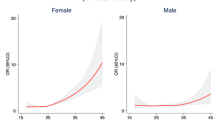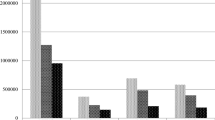Abstract
Objectives:
To determine whether the onset and duration of being overweight or obese are associated with symptoms of urinary incontinence.
Design:
Nationally representative cohort study.
Subjects:
A total of 1201 women followed-up since their birth in 1946 and annually from 48 to 54 years.
Measurements:
The body mass index (BMI) at the age of 20, 26, 36 and 43, and symptoms of stress, urge and severe incontinence at seven consecutive years from age 48 to 54.
Results:
In each year from age 48 to 54, almost half (46–49%) reported symptoms of stress incontinence, urge incontinence rose from 22 to 25% and severe incontinence from 8 to 11%. At the age of 20, 26, 36 and 43, BMI was positively associated with stress symptoms and severe incontinence in midlife. BMI transition was found to have accumulation effects on symptoms of severe incontinence; women who were overweight/obese since age 20 years were more likely to report severe incontinence than women whose BMI remained below 25 kg/m2 (odds ratio (95% confidence interval): 2.30 (1.36–3.93)) or who became overweight or obese at 43 years (1.85 (0.97–3.51)). These relationships existed beyond the effects of aging, childhood enuresis, kidney infection, childbirth characteristics, menopause, educational attainment, general practitioner consultations and smoking status. BMI was not associated with symptoms of urge incontinence.
Conclusions:
Across adult life, higher BMI for women was linked with subsequent symptoms of stress and severe incontinence in midlife; those who were overweight or obese since early in adult life more than doubled their risk of severe incontinence. Women, and especially young women, should be encouraged to keep their weight in a normal range throughout adult life.
This is a preview of subscription content, access via your institution
Access options
Subscribe to this journal
Receive 12 print issues and online access
$259.00 per year
only $21.58 per issue
Buy this article
- Purchase on Springer Link
- Instant access to full article PDF
Prices may be subject to local taxes which are calculated during checkout
Similar content being viewed by others
References
van der Vaart CH, de Leeuw JR, Roovers JP, Heintz AP . The effect of urinary incontinence and overactive bladder symptoms on quality of life in young women. BJU Int 2002; 90: 544–549.
Johnson TM, Kincade JE, Bernard SL, Busby-Whitehead J, Hertz-Picciotto I, DeFriese GH . The association of urinary incontinence with poor self-rated health. J Am Geriatr Soc 1998; 46: 693–699.
Temml C, Haidinger G, Schmidbauer J, Schatzl G, Madersbacher S . Urinary incontinence in both sexes: prevalence rates and impact on quality of life and sexual life. Neurourol Urodyn 2000; 19: 259–271.
Doran CM, Chiarelli P, Cockburn J . Economic costs of urinary incontinence in community-dwelling Australian women. Med J Aust 2001; 174: 456–458.
Turner DA, Shaw C, McGrother CW, Dallosso HM, Cooper NJ . The cost of clinically significant urinary storage symptoms for community dwelling adults in the UK. BJU Int 2004; 93: 1246–1252.
Hannestad YS, Rortveit G, Sandvik H, Hunskaar S . A community-based epidemiological survey of female urinary incontinence: the Norwegian EPINCONT study. Epidemiology of incontinence in the county of Nord-Trondelag. J Clin Epidemiol 2000; 53: 1150–1157.
Nihira MA, Henderson N . Epidemiology of urinary incontinence in women. Curr Womens Health Rep 2003; 3: 340–347.
Waetjen LE, Liao S, Johnson WO, Sampselle CM, Sternfield B, Harlow SD et al. Factors associated with prevalent and incident urinary incontinence in a cohort of midlife women: a longitudinal analysis of data: study of women's health across the nation. Am J Epidemiol 2007; 165: 309–318.
Thom D . Variation in estimates of urinary incontinence prevalence in the community: effects of differences in definition, population characteristics, and study type. J Am Geriatr Soc 1998; 46: 473–480.
Nygaard IE, Lemke JH . Urinary incontinence in rural older women: prevalence, incidence and remission. J Am Geriatr Soc 1996; 44: 1049–1054.
Kuh D, Cardozo L, Hardy R . Urinary incontinence in middle aged women: childhood enuresis and other lifetime risk factors in a British prospective cohort. J Epidemiol Community Health 1999; 53: 453–458.
Bortolotti A, Bernardini B, Colli E, Di Benedetto P, Giocoli NG, Landoni M et al. Prevalence and risk factors for urinary incontinence in Italy. Eur Urol 2000; 37: 30–35.
Chiarelli P, Brown W, McElduff P . Leaking urine: prevalence and associated factors in Australian women. Neurourol Urodyn 1999; 18: 567–577.
Dwyer PL, Lee ET, Hay DM . Obesity and urinary incontinence in women. Br J Obstet Gynaecol 1988; 95: 91–96.
Hannestad YS, Rortveit G, Daltveit AK, Hunskaar S . Are smoking and other lifestyle factors associated with female urinary incontinence? The Norwegian EPINCONT Study. BJOG 2003; 110: 247–254.
Melville JL, Katon W, Delaney K, Newton K . Urinary incontinence in US women: a population-based study. Arch Intern Med 2005; 165: 537–542.
Sampselle CM, Harlow SD, Skurnick J, Brubaker L, Bondarenko I . Urinary incontinence predictors and life impact in ethnically diverse perimenopausal women. Obstet Gynecol 2002; 100: 1230–1238.
Mommsen S, Foldspang A . Body mass index and adult female urinary incontinence. World J Urol 1994; 12: 319–322.
Bump RC, Sugerman HJ, Fantl JA, McClish DK . Obesity and lower urinary tract function in women: effect of surgically induced weight loss. Am J Obstet Gynecol 1992; 167: 392–397.
Deitel M, Stone E, Kassam HA, Wilk EJ, Sutherland DJ . Gynecologic-obstetric changes after loss of massive excess weight following bariatric surgery. J Am Coll Nutr 1988; 7: 147–153.
Subak LL, Johnson C, Whitcomb E, Boban D, Saxton J, Brown JS . Does weight loss improve incontinence in moderately obese women? Int Urogynecol J Pelvic Floor Dysfunct 2002; 13: 40–43.
Subak LL, Whitcomb E, Shen H, Saxton J, Vittinghoff E, Brown JS . Weight loss: a novel and effective treatment for urinary incontinence. J Urol 2005; 174: 190–195.
Norton P, Brubaker L . Urinary incontinence in women. Lancet 2006; 367: 57–67.
Cummings JM, Rodning CB . Urinary stress incontinence among obese women: review of pathophysiology therapy. Int Urogynecol J Pelvic Floor Dysfunct 2000; 11: 41–44.
Mohebati L, Lobstein T, Millstone E, Jacobs M . Policy options for responding to the growing challenge from obesity in the United Kingdom. Obes Rev 2007; 8 (Suppl 2): 109–115.
Wadsworth M, Kuh D, Richards M, Hardy R . Cohort profile: the 1946 national birth cohort (MRC national survey of health and development). Int J Epidemiol 2006; 35: 49–54.
Wadsworth ME, Butterworth SL, Hardy RJ, Kuh DJ, Richards M, Langenberg C et al. The life course prospective design: an example of benefits and problems associated with study longevity. Soc Sci Med 2003; 57: 2193–2205.
Kuh D, Hardy R . Women's health in midlife: findings from a British birth cohort study. J Br Menopause Soc 2003; 9: 55–60.
WHO. Obesity: preventing and managing the global epidemic. Report of a WHO Consultation. WHO Technical Report Series 894 2000. World Health Organization: Geneva.
Holroyd-Leduc JM, Straus SE . Management of urinary incontinence in women: scientific review. JAMA 2004; 291: 986–995.
McKinlay SM, Brambilla DJ, Posner JG . The normal menopause transition. Maturitas 1992; 14: 103–115.
Clennell S, Kuh DL, Guralnick J, Patel K, Mishra GD . Characterisation of smoking behaviour across the life course and its impact on decline in lung function and all-cause mortality: evidence from a British birth cohort. J Epidemiol Community Health 2008, in press.
Twisk JWR . Applied Longitudinal Data Analysis for Epidemiology. Cambridge University Press: Cambridge, 2003, pp 131–140.
SAS. SAS/STAT User's Guide Version 8. SAS Institute Inc: Cary, NC, 1999.
Alling ML, Lose G, Jorgensen T . Risk factors for lower urinary tract symptoms in women 40–60 years of age. Obstet Gynecol 2000; 96: 446–451.
Noblett KL, Jensen JK, Ostergard DR . The relationship of body mass index to intra-abdominal pressure as measured by multichannel cystometry. Int Urogynecol J Pelvic Floor Dysfunct 1997; 8: 323–326.
Persson J, Wolner-Hanssen P, Rydhstroem H . Obstetric risk factors for stress urinary incontinence: a population-based study. Obstet Gynecol 2000; 96: 440–445.
Acknowledgements
The Wellcome Trust Grant provided financial support for GM. The Medical Research Council provided funding for the National Survey of Health and Development and financial support for DK, RH.
Author information
Authors and Affiliations
Corresponding author
Additional information
Conflict of interest
None.
Rights and permissions
About this article
Cite this article
Mishra, G., Hardy, R., Cardozo, L. et al. Body weight through adult life and risk of urinary incontinence in middle-aged women: results from a British prospective cohort. Int J Obes 32, 1415–1422 (2008). https://doi.org/10.1038/ijo.2008.107
Received:
Revised:
Accepted:
Published:
Issue Date:
DOI: https://doi.org/10.1038/ijo.2008.107
Keywords
This article is cited by
-
Urinary Incontinence in Midlife According to Weight Changes Across and After Childbearing Years
International Urogynecology Journal (2024)
-
U-shaped association between sleep duration and urgency urinary incontinence in women: a cross-sectional study
World Journal of Urology (2023)
-
Prevalence of urinary incontinence in women powerlifters: a pilot study
International Urogynecology Journal (2019)
-
Urogenital symptoms: prevalence, bother, associations and impact in 22 year-old women of the Raine Study
International Urogynecology Journal (2018)
-
Urinary incontinence in women
Nature Reviews Disease Primers (2017)



